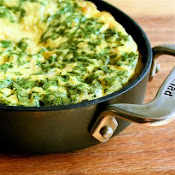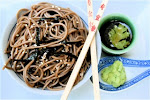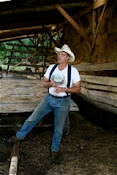 I hate to be Debbie Downer, but I must share some disheartening news with you about olive oil. The extra-virgin olive oil you find at your local supermarket very likely is not extra-virgin at all. It turns out that the USDA doesn't even recognize classifications such as “extra-virgin.” As a result, bottlers all over the world can blend olive oil with cheaper vegetable oils and sell it for a premium price as “extra-virgin." If you care to learn more about the widespread fraud in the olive oil industry read this: Slippery Business, The New Yorker, August 13, 2007.
I hate to be Debbie Downer, but I must share some disheartening news with you about olive oil. The extra-virgin olive oil you find at your local supermarket very likely is not extra-virgin at all. It turns out that the USDA doesn't even recognize classifications such as “extra-virgin.” As a result, bottlers all over the world can blend olive oil with cheaper vegetable oils and sell it for a premium price as “extra-virgin." If you care to learn more about the widespread fraud in the olive oil industry read this: Slippery Business, The New Yorker, August 13, 2007.A recent visit to the Temecula Olive Oil Company's shop forever changed how I think about olive oil. I learned so many incredible things, but I cannot, I regret, share them all with you at this moment. You'll just have to trust me that the company is awesome, their olive oil is delicious, and, as with all foods it seems, it pays to know your grower.
Now, about this recipe. I made this cake — a longtime family favorite — using the TOOC's citrus extra-virgin oil, and never has it tasted so delicious. I didn't even use fresh-squeezed orange juice (the horror!). As you can see, I baked this batch in my mini springform pans, but a standard 9-inch springform pan works just as well. This cake puffs up a touch when it bakes, and sinks slightly when it cools. It is moist and delicious, perfect with coffee or tea, and only needs a dusting of powdered sugar to make it fit for consumption.
Note: If you cannot get TOOC extra-virgin olive oil or any other extra-virgin oil you know to be from a credible source, use an olive oil as opposed to an extra-virgin olive oil. I've made this cake with e.v.o.o. from the grocery store and the taste is too overpowering. That is not the case, however, with TOOC oil.

 Oh, and apparently it's tradition to make a cake on Election Day. My mother recently emailed me an article that offers several accounts of the cake's history, which dates to 1771.
Oh, and apparently it's tradition to make a cake on Election Day. My mother recently emailed me an article that offers several accounts of the cake's history, which dates to 1771.Oh, and if you're looking to bake a traditional Election Day cake next Tuesday, here's a recipe:
Election Cake - Thirty quarts of flour, 10 pound butter, 14 pound sugar, 12 pound raisins, 3 doz eggs, one pint wine, one quart brandy, 4 ounces cinnamon, 4 ounces fine colander seed, 3 ounces ground alspice; wet flour with milk to the consistence of bread over night, adding one quart yeast; the next morning work the butter and sugar together for half an hour, which will render the cake much lighter and whiter; when it has rise light work in every other ingredient except the plumbs, which work in when going into the oven.
Recipe from Amelia Simmon's cookbook American Cookery, 2nd Edition, 1796.
 Orange And Olive Oil Cake
Orange And Olive Oil CakeYield = One 9-inch cake or six 4-inch cakes, Serves 10-12 people
Butter for greasing the pan
1½ cups all-purpose flour
½ tsp. baking powder
¼ tsp. baking soda
pinch of salt
2 eggs
1¾ cups sugar
2 tsp. grated orange zest
2/3 cup freshly squeezed orange juice (the juice from about 2 oranges)
2/3 cup olive oil, such as any made by the Temecula Olive Oil Company,
Note: If you cannot get TOOC oil or oil you know to be from a credible source, use olive oil as opposed to extra-virgin olive oil.
1. Preheat the oven to 375ºF. Butter a springform pan (or pans) or a 9-inch cake pan. (If using a cake pan, place a round of parchment paper in the bottom of the pan.)
2. Whisk together the flour, baking powder, baking soda and salt.
3. With an electric mixer, beat the eggs until blended, then gradually add in the sugar, beating until thick. The mixture will be pale yellow. In a separate bowl, whisk the zest, juice and oil. Add to the egg mixture in thirds alternating with the flour mixture.
4. Spread batter into pan and bake for about 50 minutes, until a toothpick comes out clean. Cool on rack for 15 minutes.
5. Sift confectioners’ sugar over top before cutting and serving.


1. Preheat the oven to 375ºF. Butter a springform pan (or pans) or a 9-inch cake pan. (If using a cake pan, place a round of parchment paper in the bottom of the pan.)
2. Whisk together the flour, baking powder, baking soda and salt.
3. With an electric mixer, beat the eggs until blended, then gradually add in the sugar, beating until thick. The mixture will be pale yellow. In a separate bowl, whisk the zest, juice and oil. Add to the egg mixture in thirds alternating with the flour mixture.
4. Spread batter into pan and bake for about 50 minutes, until a toothpick comes out clean. Cool on rack for 15 minutes.
5. Sift confectioners’ sugar over top before cutting and serving.



























































































































































